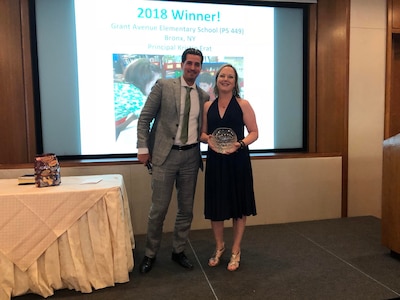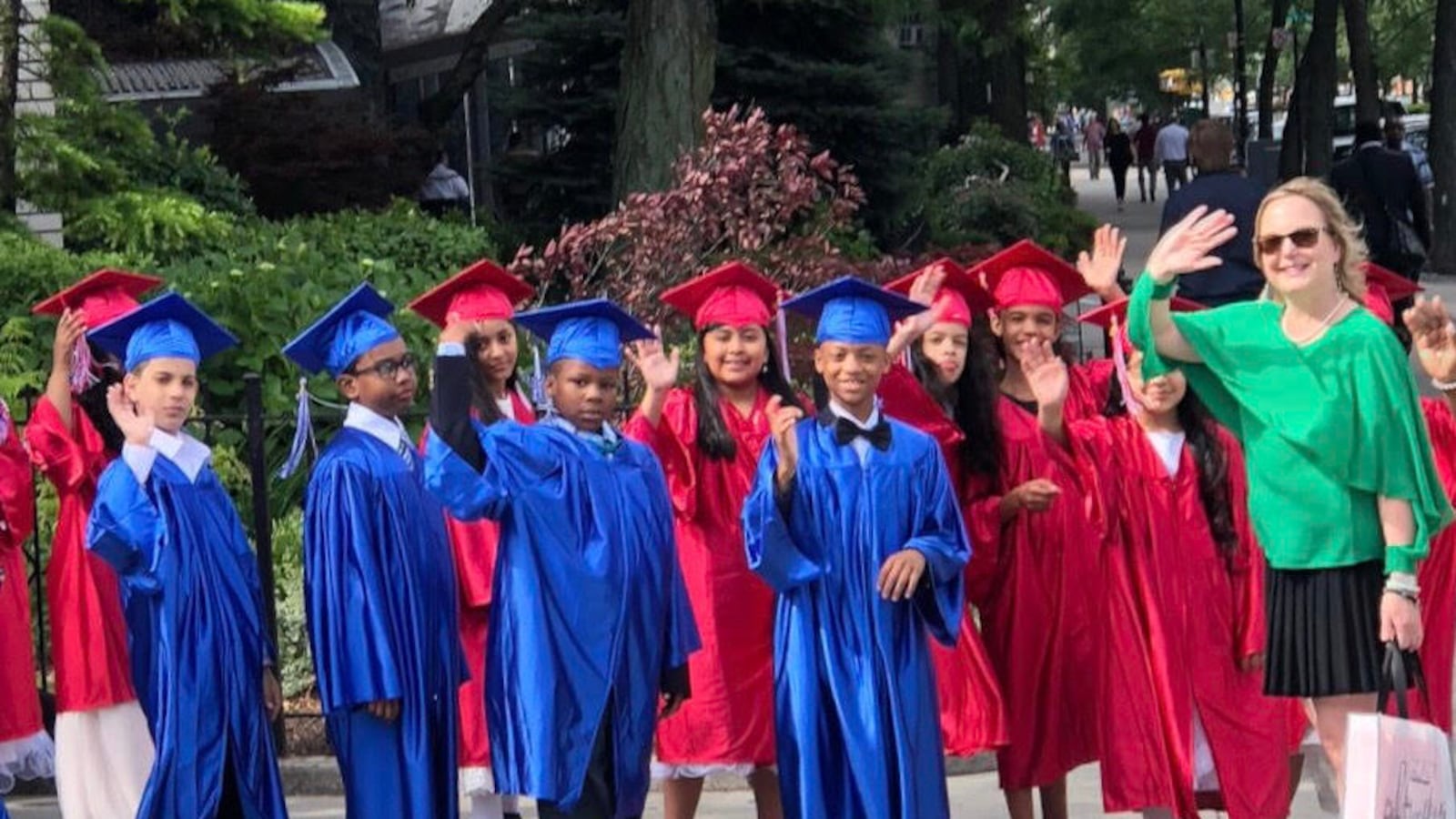Here, in a series we call “How I Lead,” we feature principals and assistant principals who have been recognized for their work. You can see other pieces in the series here.
In a unanimous decision last week, principal Kristin Erat won the Teaching Matters Elizabeth Rohatyn Prize on behalf of her school, an annual award that bestows $25,000 on a public school in or around New York City to spend on advancing opportunities for students by helping to position their teachers, in the words of the prize criteria, to “lead, learn, and thrive.”
As the founding principal of Grant Avenue Elementary School, which opened in the Bronx in 2009, Erat knew she wanted to create a collaborative community for teachers, families and students. Although the school quickly developed a strong literature program, mathematics proved to be a heavier lift. That changed when Grant Avenue became part of the DOE-funded Learning Partners Program two years ago. The initiative, started by former Chancellor Carmen Fariña, seeks to improve schools through internal and external collaboration. Principal Erat and her assistant principal have used the funds from this program to support teachers sharing innovative ways to provide students with a stronger conceptual understanding of mathematics.
While reflecting on the changes she has seen within the past couple of years, Erat discussed and highlighted some of the reasons why she believes the school’s work attracted recognition.
This interview has been condensed and lightly edited.
Describe the work that you are doing. How will the prize money help you expand on that work?
In the past we had really flat and bad math data – we were at 12 percent proficiency for a number of years. At the time, we were using a very procedural, highly scripted curriculum. Teachers would just go lesson by lesson, using the workshop model of ‘I do, you do, we do,’ and basically what we found was that our students were compliant, but there was limited transfer in terms of conceptual understanding of mathematics. Because the way the curriculum was set up, teachers also had a limited conceptual understanding of the material, because they were teaching lessons in isolation and going by a script. So, two years ago we decided to rip off the bandaid and move in a radically different direction and became part of the Learning Partners program in New York. Principals, assistant principals and teachers are a part of it. To start as a host school, you identify a problem of practice – in our case, that was around mathematics – and you set up day-long visitations where other schools visit classes, take notes and then gather feedback for the school that should give [its teachers] a new direction to go in. For our host work, we would always use a professional text to study, which in our case was the 5 Practices For Orchestrating Mathematical Discussion. Whenever we were trying something new, we would have a core group of teachers trying it out to see if it’s working and based on the impact, we would decide where to go next. The funding from the DOE is set up to stop formally after three years, so the money from the prize will go to all of these initiatives that support teacher leadership in the community. The prize will work in two directions – it will go towards the work we are doing around innovating how we taught mathematics and towards the visitations within the school (and the ones that support other city schools) to help them roll out practices.
Why do you think you won this award, and what about your work made it stand out?
I happen to have worked with every one of the other principals who were up for consideration in various roles. I know that they are all very strong leaders. I have experienced their leadership and know they are doing tremendous work in their schools. So in a sense, it was difficult to win, because you know you’re standing in a room with other folks who are doing terrific work. I was really proud of winning, and I think the reason we won was because the work that we were doing fit so well with the the language of the award, which is given to highlight leadership and excellent work taking place in a school, always with a focus on teacher effectiveness. My assistant principal and I believe that the more invested we are in supporting teachers in professional growth, the more students will be taken care of. We also demonstrated a huge impact in advancing opportunities for students and by positioning teachers to “lead, learn and thrive.”

How do you train your teachers to become leaders? What are the specific strategies you use?
In our professional development blocks, we have dedicated time set up for mini-courses, where teachers will be leading six to eight different colleagues and will work on a particular area of practice, like using backwards design to prepare for math units. At the end of each year, teachers can either nominate themselves or their colleagues for a particular area of strength that folks think others can benefit from, and on Mondays, colleagues can sign up for one of the mini-courses and work alongside those colleagues to learn. Teachers are broken up into teams, and each of the teams have a mathematics representative and a literary representative who meet with me monthly. We have model teachers and peer-collaborative teachers. The model teachers are the teachers who use their classrooms as places to get together with administration and to demonstrate teaching techniques, and they visit each other to give each other feedback. Peer-collaboration teachers teach during half of their schedule and coach during half of their schedule. They receive a stipend on top of their salary, and it’s a great way to ensure that your strongest teachers are growing in their practices and are incentivized to stay. Their coaching is one-on-one throughout the year.
How have the new teaching methods transformed your community? What are some of the major changes you have seen?
We are known as a school to visit around literacy practices, but unfortunately math was neglected. It was not an area of emphasis. From a teacher and student standpoint, attitudes about math were low, but now we see something completely different. One of the elements that has been really powerful is work that we have drawn from 5 Practices For Orchestrating Mathematical Discussion. A specific practice we do is that students in a class are given a grade-level task and virtually no teaching before taking the test. We call the problems they’re given ‘persevere problems’ and say that they have to use all they know about math to unpack the problem. While students are independently working, the teacher is circling and seeing what students are using – models, previous lessons, common misconceptions. The teacher then selects three to four students to present their work in front of class, but in a way where each example links to a connection or math understanding that will lead to the answer. It used to be that kids would get a test, and you would see slumped shoulders and upset students. But these instructions happen two to three times per week, and you see kids energized and encouraging each other during them with questions and feedback. Since starting, we have had huge gains from 12 percent proficiency to 31 percent proficiency, and I know that when our results come back this year, we will see more gains.
Can you describe a specific instance or an anecdote that you think is reflective of the changes that you have seen?
One of the exciting aspects of this work is that sometimes people hear “model teacher” or “teacher leader” and perceive that to mean that that person knows it all, but in fact some of our most beautiful and challenging moments came from model teachers being learners. One of our teachers in particular, when we had to talk about changes to make, would be tearful and ask why she was teaching if she didn’t know what she was doing. She is very competent, and it was uncomfortable to have to learn to teach a different way and to then have to teach that to someone else. She’s someone whom we talk about all the time though, because she teaches the third grade special education class that outperformed the city on the math test. There were lots of tears in the beginning, but we come to work every day because we want our students to succeed.
How do you ensure parents grow with the community as well?
Every Friday we have ‘Family Fridays’ in the early afternoon, and parents are welcome in the classroom to engage in learning with their child. We have a strong parent leadership team that works on crafting goals as well. It’s mainly the little things, like we get 100 percent engagement with parent conferences. It’s just the expectations we have for our parents. These conversations we’re having are important, and meetings have to be a two-way dialogue. On parents’ night, we also have a scavenger hunt where parents have to meet with at least seven educators who work with their child. The more informal opportunities parents have to get to know teachers, the easier the serious conversations will be because there is already a relationship built.

